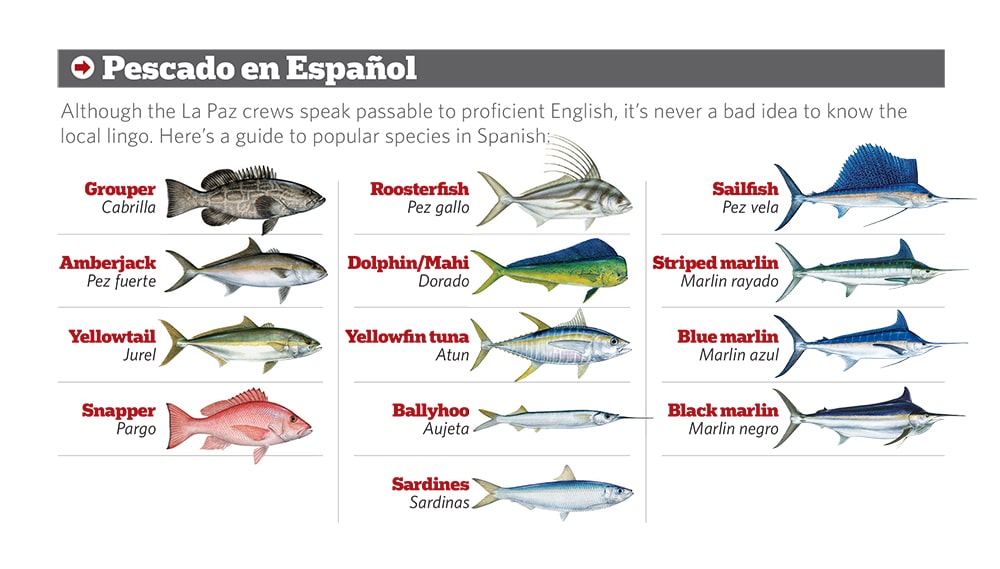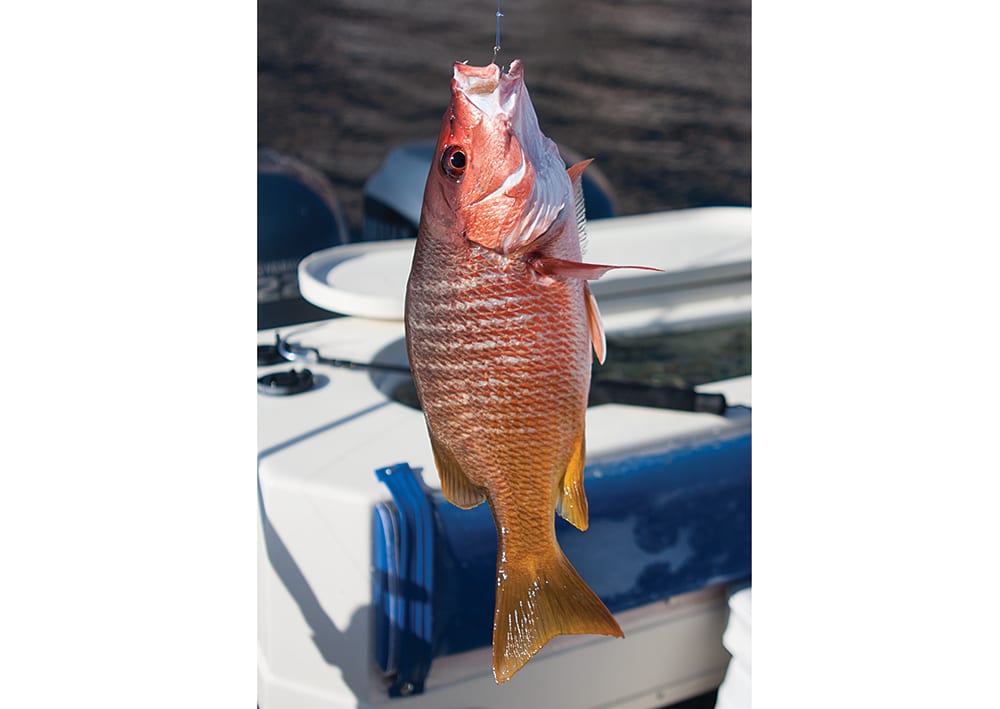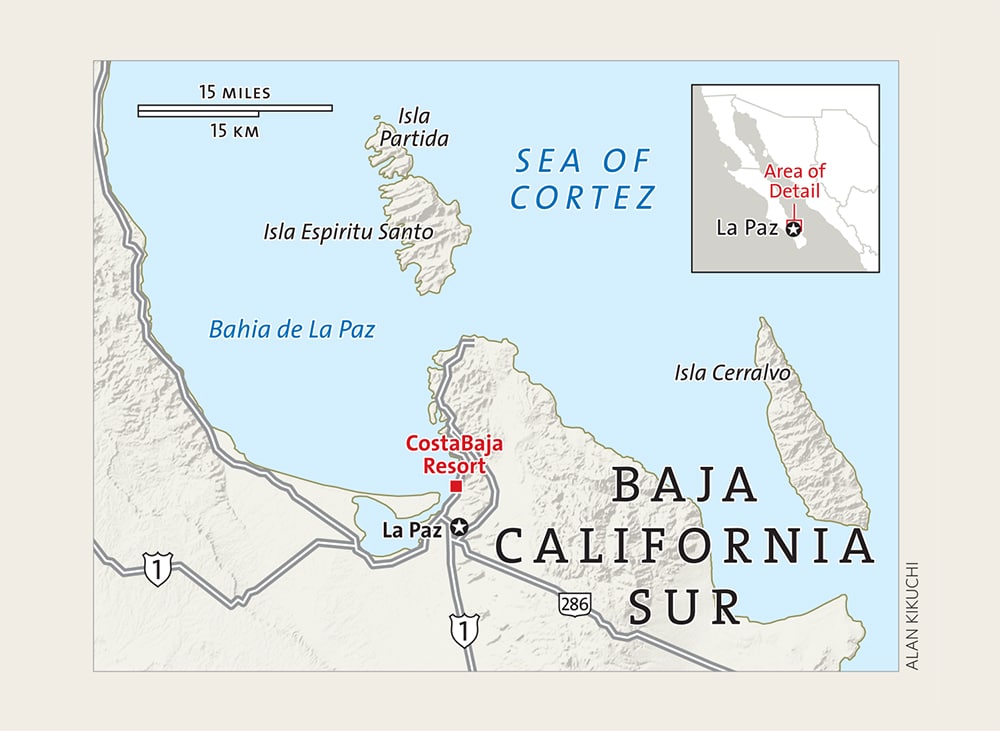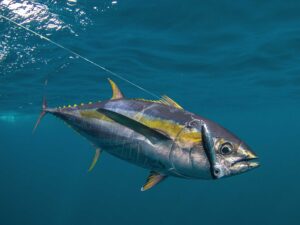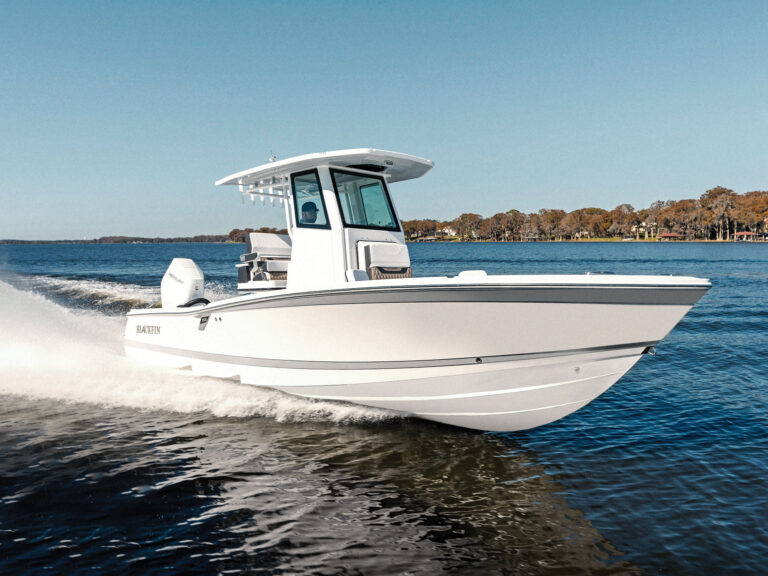
[Be sure to click through all the images in the gallery above.]
I blinked twice to refocus, then scanned the glistening surface again. Within seconds, the spectacle I had just witnessed repeated itself. Another hefty grouper, in hot pursuit of a frantic ballyhoo, cleared the water like a trophy largemouth bass before crashing back in a frothy spray. I turned to our guide, Capt. Luis Lieras, for confirmation.
“No señor, you are not going crazy,” he told me with a hearty laugh. “Those are cabrilla, and they are going crazy for the aujeta, or ballyhoo. It’s not unusual. But it happens for only a short time every spring when the conditions are right, like they are now. Let’s get the baits out and catch some.” My host, Mike Merino, and I quickly readied the rods as the blitz continued. We wouldn’t have long to wait.
I had met Merino and his wife, Julie, at the CostaBaja marina the night before. Like me, the Portland, Oregon, couple were exploring La Paz for a few days on a fishing vacation, and had been racking up quality yellowtail and cabrilla with Lieras’ help. When they invited me to join them for their last outing the following day, I gladly accepted.
The next morning, we loaded the couple’s 20-foot Grady-White center console with gear as the sun eased over the mountaintops. After clearing the idle zone, Lieras accelerated for the short run to buy bait from local fishermen. With large scoops of frisky sardines stowed in the livewell, we made our way around the point and ran along the coast. This was my first visit to La Paz, and I was struck by the clear blue-green water and the numerous coves that were hideouts for pirates in earlier times. Today, those coves are gathering spots for spawning ballyhoo, as Lieras explained.
“In spring, the ballyhoo come into these shallow coves to lay their eggs in the seaweed, and the cabrilla follow,” he said. “By May and early June, the sargassum breaks free and releases the eggs. That attracts the flyingfish, followed by dorado and striped marlin. It doesn’t last long, but it’s fun while it does.”
As if to put an exclamation point on that statement, the starboard rod bent over with a savage strike. Merino was ready. After a brief stand-off, he skillfully coaxed the fish up from the 20-plus-foot depths. A few minutes later, a mottled-brown cabrilla, or leopard grouper, was hoisted aboard.
“When I’m slow-trolling or drifting with this tackle, I put the reel clicker on and keep my thumb on the spool,” Lieras explained. “When the fish hits, give it a two-count and engage the gear, or the cabrilla will go under a clump of seaweed and pull loose.”
We were using an assortment of medium conventional outfits spooled with corresponding monofilament line. A two-foot length of 60-pound fluorocarbon leader was added with a blood knot. Lieras prefers a size 3 or 4 live-bait hook for the sardines. A ring-eye hook or a loop knot allows the bait to swim more naturally.
To force the sardines to swim down into the strike zone near the rocky bottom, Lieras pops out one of the bait’s eyes with his thumb. He also live-chums by bouncing the sardines off the transom and engine cowling to stun them so they circle erratically on the surface. Every few minutes, he’d dip a small bucket into the live well, and then sling the water overboard with a side-to-side motion to mimic showering bait. These enticements helped us box a few more cabrilla, although some managed to get free in thick underwater vegetation. Our stash of sardines slowly dwindled.
By midmorning, the cabrilla lost interest in the sardines, yet the cove remained active. Pods of ballyhoo erupted on the surface, and the subsequent feeding frenzy of predators drew pelicans and gulls into the melee. When Lieras spotted more showering ballyhoo closer to the boat, he ordered us to reel in the lines as he readied the cast net. Merino steered the boat into range, and a couple throws of the net filled the well to capacity with half-beaks. Quickly switching to heavier tackle and 3/0 to 4/0 bait hooks, we put live ballyhoo back out. Within minutes, Julie was straining to battle with another hefty cabrilla.
Once we “matched the hatch,” the bite turned on again. We had boated a few more grouper when I heard a telltale click on the aft starboard rod. I grabbed the Senator 114/Sabre rod combo only to have it almost yanked out of my hands. I set the hook and the fight was on. Pure brute strength telegraphed up the line as my opponent stayed down, concealing its identity. Finally, the unmistakable serrated dorsal fin broke the surface, and I realized I was tight to my biggest roosterfish yet. It wasn’t ready to surrender though, and matched the 80-pound-test line pound for pound. Twenty minutes later, based on its overall size and the massive girth of its tail, we let the estimated 80-pounder swim away. A cold celebratory cerveza helped soothe my aching biceps.
“The roosters like the aujeta too,” Lieras said, laughing. “And when the ballyhoo come into the shallows to spawn, the yellowtail and sierra mackerel will come in to feed on them also.” Lieras looks for depths of 30 feet or less with the rocky bottom that anchors the vegetation growing toward the surface. With numerous coves and protected shorelines only a short distance from La Paz, the area is ideally suited for midsize boats and pangas. Aside from local marinas, there are several places to launch from the beach with a four-wheel-drive tow vehicle, a prospect that intrigues the Merinos.
“We’ve quickly fallen in love with La Paz,” Mike told me on the ride back, as Julie soaked up the rays. “CostaBaja has everything a visiting boater needs: ramp, modern marina and service, all the amenities. The city still has the charm of Old Baja. And best of all, the fishing is great. It’s the perfect spot for a spring-fishing fling. We’ll be back for sure.”
So will I.
La Paz, Baja California Sur, Mexico Tackle Box
While the inshore fishing on the spawning ballyhoo is primarily a live-bait fishery, there’s plenty of opportunity for casting lures when the predators are blitzing the ballyhoo schools. A selection of lures is easier to carry along than to find once you are there. Effective casting lures include diving plugs, such as Rapala Magnum CD-14/18, diamond jigs, Luhr Jensen Crippled Herring or casting spoons.
- Rods: 61⁄2- to 7-foot medium-heavy conventional or spinning with limber tip and stout butt section
- Reels: Avet or Penn Senator conventional; Daiwa Saltist or Fin-Nor Offshore spinning in 5000- to 7000-class sizes
- Lines: 30- to 50-pound-test monofilament or braid up to 80-pound-test
- Leader: Two feet of 60-pound-test fluorocarbon connected to the main line with a blood knot or double uni-knot
- Lures: Rapala Magnum CD-14/18 diving plugs, Mold Craft and Williamson ballyhoo, 6- to 8-ounce metal casting jigs
- Baits: Live ballyhoo and sardines, readily available locally
Trip Planner
- What: Grouper, roosterfish, yellowtail, snapper
- When: January to June
- Where: La Paz, Baja California Sur
- Who: CostaBaja resort, 888-866-9394, costabaja.com
CostaBaja is a 550-acre residential community with hotel, beach club, golf course, and marina with restaurants, shops, and galleries, five minutes from downtown La Paz overlooking the Sea of Cortez. The modern marina has 250 slips for yachts up to 225 feet; built-in pump-out stations, television and Internet access, 24-hour security, the largest fuel dock in the area, potable desalinated water, and complete boat services. With an abundance of accessible fishing and modern facilities, La Paz has long been a popular destination for trailer boaters who undertake the 950-mile drive from San Diego.
Charters and Captains
- Capt. Scott Canahan, 52-1-612-159-0474, desertjewelcharters.com
- Baja Pirates Fishing Fleet, 866-454-5386, bajapirates.com
- Tailhunter International Sportfishing Fleet, 626-638-3383, tailhunter-international.com



